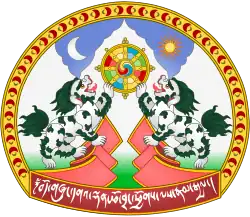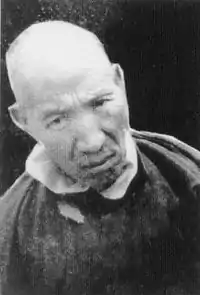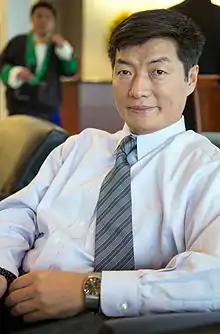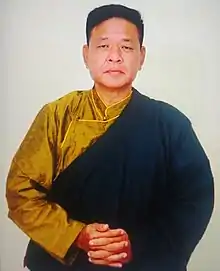Sikyong
The Sikyong (Tibetan: སྲིད་སྐྱོང༌, Wylie: srid-skyong, Lhasa dialect: [ˈsícóŋ]) is the political leader of the Central Tibetan Administration, a Tibetan exile organisation in India also known as the Tibetan Government-in-Exile based on the 2011 Charter of Tibetans-in-exile. The title was created in 2012 after the 14th Dalai Lama decided not to assume any political and administrative authority as the head of the Tibetan Administration for Tibetans-in-exile.
| Head of the Central Tibetan Administration | |
|---|---|
| སྲིད་སྐྱོང༌ | |
 Emblem of Tibet | |
| Central Tibetan Administration | |
| Style | His Excellency |
| Member of | Cabinet |
| Residence | Dharamsala, India |
| Appointer | Direct popular vote |
| Term length | Five years |
| Formation | 1907 (as Kalön Tripa) 8 August 2011 (as Sikyong) |
| Website | www |
The current Sikyong is Penpa Tsering. The Sikyong is the political leader of the Kashag, part of the executive branch of the Central Tibetan Administration. This office should not be confused with the "Chairman of the People's Government of the Tibet Autonomous Region" (西藏自治区人民政府主席).
The first directly elected Kalön Tripa was Lobsang Tenzin, the Samdhong Rinpoche, who was elected August 20, 2001.[1] Based on the 13-Article Ordinance for the More Effective Governing of Tibet, Kashag should be composed of three temporal officials and one monk official. Each of them held the title of Kalön (Tibetan: བཀའ་བློན་, Wylie: bkaʼ-blon, Lhasa dialect: [kálø ̃]; Chinese: 噶倫; pinyin: gálún), should seek appointment from the Central Government.[2]
Before 2011, the Kalön Tripa position was subordinate to the 14th Dalai Lama[3] who presided over the government in exile from its founding.[4] In 2011, the Dalai Lama announced that his political authority would be transferred to Sangay.[5]
Kalön Tripa
On September 20, 2012, the 15th Tibetan Parliament-in-Exile unanimously voted to change the title of Kalön Tripa to Sikyong in Article 19 of the Charter of the Tibetans in exile and relevant articles.[6] The Dalai Lama had previously referred to the Kalon Tripa as Sikyong, and this usage was cited as the primary justification for the name change. According to Tibetan Review, "Sikyong" translates to "political leader".[7] The online Dharma Dictionary translates sikyong (srid skyong) as "secular ruler; regime, regent".[8]
Kalön Tripa
Tibet
| No. | Portrait | Name (birth–death) |
Term of office | Dalai Lama | Ref. | ||
|---|---|---|---|---|---|---|---|
| Took office | Left office | Time in office | |||||
| 1 |  |
Tsarong Wangchuk Gyalpo (1903–c. 1912) |
1903 | 1912 | 8–9 years | 13th Dalai Lama (1879–1933) | |
 |
Chankhyim Trekhang Thupten Shakya (?–c. 1920) |
1907 | 1920 | 12–13 years | |||
 |
Paljor Dorje Shatra (c. 1860–c. 1926) |
1907 | 1923 | 15–16 years | |||
.jpg.webp) |
Sholkhang Dhondup Phuntsog (1862–1926) |
1907 | 1926 | 18–19 years | |||
| 2 |  |
Langdun (1906–1980) |
1926 | 1940 | 13–14 years | 13th Dalai Lama (1879–1933) 14th Dalai Lama (1937–1950) |
|
| 3 |  |
Lobsang Tashi (1897–1966) |
1950 | 27 April 1952 | 1–2 years | 14th Dalai Lama (1937–1950) |
|
 |
Lukhangwa (1895–1966) |
1950 | 27 April 1952 | 1–2 years | |||
Kashag
| No. | Portrait | Name (birth–death) |
Term of office | Dalai Lama | Ref. | ||
|---|---|---|---|---|---|---|---|
| Took office | Left office | Time in office | |||||
| 1 |  |
Jangsa Tsangy | 1959 | 1960 | 0–1 years | 14th Dalai Lama in exile (1950–present) |
|
| 2 |  |
Surkhang Wangchen Gelek (1910–1977) |
1960 | 1964 | 3–4 years | ||
| 3 |  |
Gyurme Sonam Topgyal (1896–1967) |
1965 | 1967 † | 1–2 years | ||
| 4 |  |
Garang Lobsang Rigzin (1905–?) |
1970 | 1975 | 4–5 years | ||
| 5 |  |
Kunling Woeser Gyaltsen (1915–2001) |
1975 | 1980 | 4–5 years | ||
| 6 |  |
Wangdue Dorjee (1919–1994) |
1980 | 1985 | 4–5 years | ||
| 7 |  |
Juchen Thupten Namgyal (1929–2011) |
1985 | 1990 | 4–5 years | ||
| 8 |  |
Kalsang Yeshi (born 1941) |
1990 | 1991 | 0–1 years | ||
| 9 |  |
Gyalo Thondup (born c. 1927) |
1991 | 1993 | 1–2 years | ||
| 10 |  |
Tenzin Tethong (born 1947) |
1993 | 1996 | 2–3 years | ||
| 11 | .jpg.webp) |
Sonam Topgyal (1940–2012) |
April 1997 | 5 September 2001 | 4 years, 5 months | [9] | |
| 12 |  |
Lobsang Tenzin (born 1937) |
5 September 2001 | 8 August 2011 | 9 years, 337 days | ||
| 13 |  |
Lobsang Sangay (born 1968) |
8 August 2011 | 20 September 2012 | 1 year, 43 days | ||
Sikyong
| No. | Portrait | Name (birth–death) |
Term of office | Cabinet[10] | Elected | Ref. | ||
|---|---|---|---|---|---|---|---|---|
| Took office | Left office | Time in office | ||||||
| 1 |  |
Lobsang Sangay (born 1968) |
20 September 2012 | 21 May 2021 | 8 years, 243 days | 14th cabinet | 2011-12 | |
| 15th cabinet | 2016-17 | |||||||
| 2 |  |
Penpa Tsering (born 1967) |
21 May 2021 | Incumbent | 2 years, 157 days | 16th cabinet | – | |
| 17th cabinet | 2021-22 | |||||||
References
- Donovan Roebert, Samdhong Rinpoche: Uncompromising Truth for a Compromised World (World Wisdom, 2006) ISBN 978-1-933316-20-8 (On August 20, 2001, Venerable Professor Samdhong Rinpoche was elected Kalon Tripa (Prime Minister) of the Tibetan Government in Exile, receiving 84.5% of the popular exile vote.)
- Jiawei Wang; Gyaincain Nyima; Jiawei Wang (1997). The Historical Status of China's Tibet. pp. 58–. ISBN 978-7-80113-304-5.
- The Charter of Tibetans in-Exile, Article 20 of the Constitution of Tibet, retrieved 2010-03-19.
- The Charter of Tibetans in-Exile, Articles 19, 30, & 31 of the Constitution of Tibet, retrieved 2010-03-19.
- Dean Nelson Lobsang Sangay: profile, The Telegraph, 08 Aug 2011
- "Tibetan Parliament changes 'Kalon Tripa' to 'Sikyong'". Archived from the original on 2019-05-02. Retrieved 2012-09-24.
- "Kalon Tripa to be now referred to as Sikyong". Tibetan Review. 2012-09-22. Archived from the original on 2013-10-17. Retrieved 2012-12-11.
- "Srid skyong - Rangjung Yeshe Wiki - Dharma Dictionary".
- Jay, Sophie (31 December 2012). "Former Tibetan prime minster, Sonam Topgyal, dies in Dharamshala". thetibetpost.com. Tibet Post International. Retrieved 24 November 2021.
- "The Kashag (Cabinet)". Central Tibetan Administration. Retrieved 24 November 2021.
External links
- Speech/transcription
- Penpa Tsering sworn in as the Sikyong of 16th Kashag
- Key note address by Dr. Lobsang Sangay, Kalon Tripa, Tibetan Government in Exile on 06 September 2011 at the VIF Seminar on Tibet
- Elections